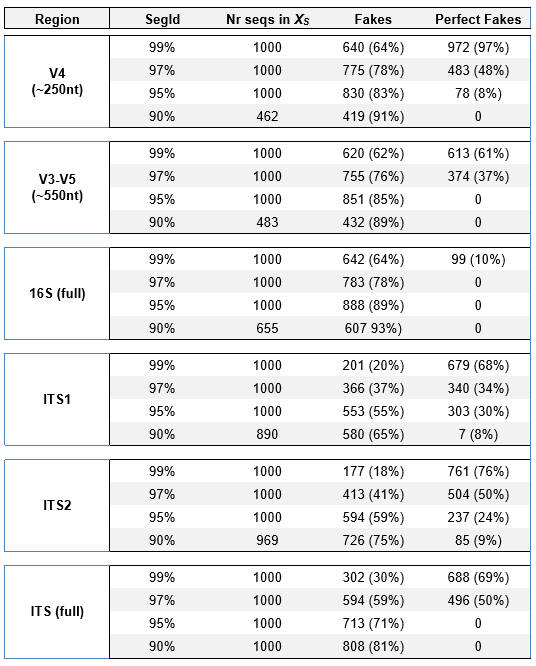Fake chimeras
See also
Chimeras
Low-divergence chimeras
are common
Given a query sequence Q, a chimeric model
is a pair of reference sequence segments (A, B) concatenated together that
have divergence > 0, i.e. are more similar to Q than the most similar
sequence in the database (the top hit, T). If Q is not chimeric, the model
is fake. A perfect fake model is a fake model that is
identical to Q.
To give an indication of the frequency of fake models
found by UCHIME2 I counted the number of
alignments with a positive score, ignoring all other thresholds. Results are
shown in the "Fakes" column in the table below (taken from the UCHIME2
paper). These are underestimates of the number of fake models that could be
constructed, noting for example that this method fails to find many perfect
fake models with S=99% found by UCHIME2-denoised.
All queries with at
least one perfect fake model are guaranteed to be identified by
UCHIME2 in denoised mode because the algorithm is not heuristic, in the
following sense: if one or more chimeric models exist, and the query
sequence is not present in the database, then a model will be reported.
The observation that both fakes and perfect fakes are very common
implies that chimeras cannot be reliably distinguished from non-chimeras by
any conceivable reference-based algorithm. In the de novo case, sequence
abundances provide additional evidence which is predictive but not
definitive. Similarly, it is not possible to screen large reference
databases such as SILVA or Greengenes for chimeras with high accuracy.
Low-divergence chimeras are common, and
if the parents of a low-divergence chimera are present in the database, an
algorithm such as UCHIME2-denoised can discover the model, but would not be
able to reliably determine whether the model was fake because there is no
evidence either way in the sequence. If its parents are not present, then
the sensitivity and/or error rate of all algorithms necessarily increase
rapidly with decreasing S and again, if a model is found, a chimera cannot
be reliably distinguished from a correct biological sequence with a perfect
or imperfect fake model.

Table shows the number of fake models found by
UCHIME2-sensitive and number of perfect fake models found by
UCHIME2-denoised. For all regions except full-length 16S, a large majority
of sequences have a perfect fake model with segment id (S) = 99% and between
a third and a half with S=97%.
Reference (please cite)
R.C. Edgar (2016), UCHIME2: improved chimera prediction for amplicon sequencing, https://doi.org/10.1101/074252
• UCHIME2 algorithm, improved chimera detection
• "Fake" chimeras are common, valid biological sequences matching two-parent model
• Perfect chimera filtering impossible even with complete and correct reference
• Realistic chimera benchmark




